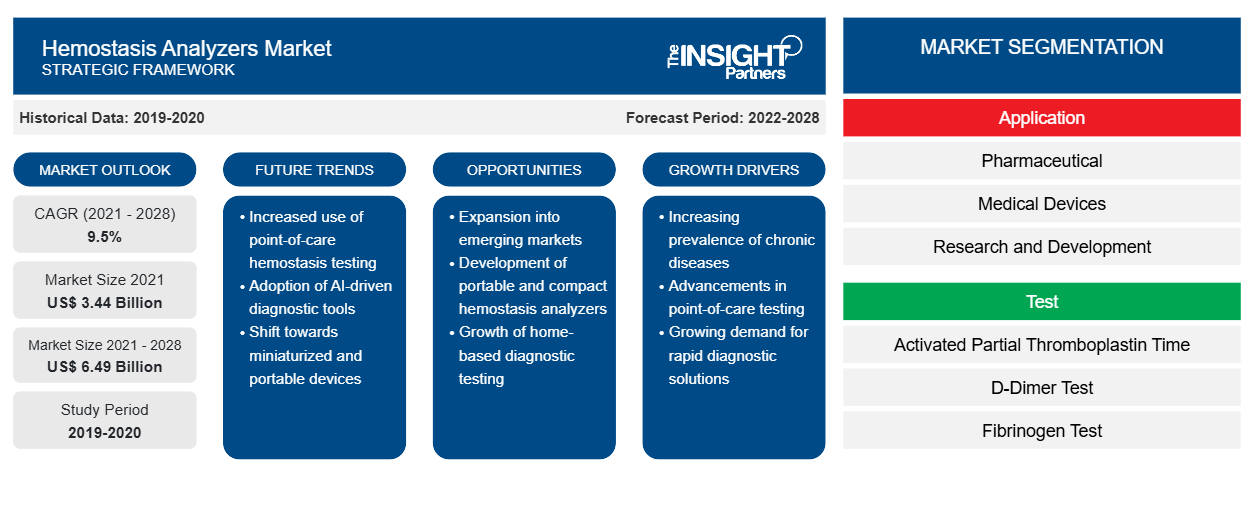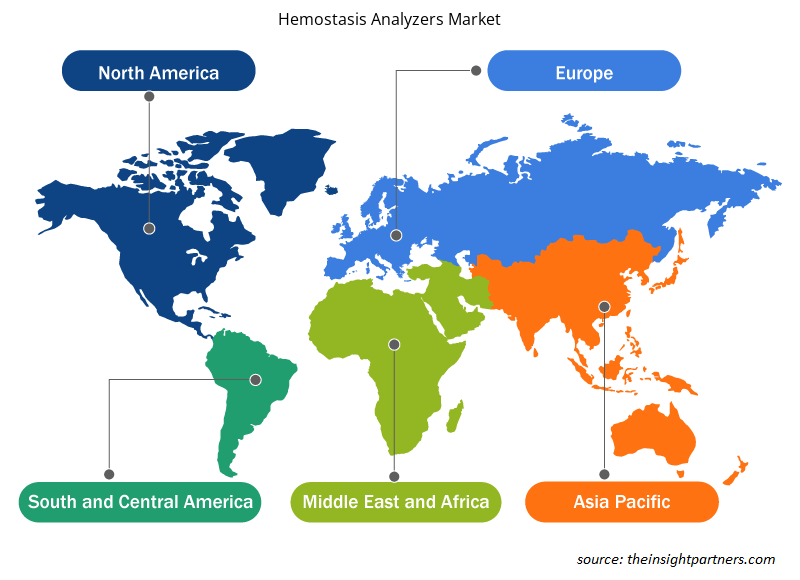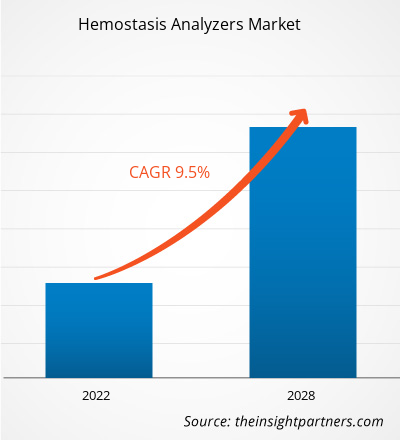The hemostasis analyzers market is projected to reach US$ 6,490.24 million by 2028 from US$ 3,440.66 million in 2021; it is expected to register a CAGR of 9.5% from 2021 to 2028.
Hemostasis analyzers provide a quick and easy measurement of blood platelet levels. A coagulation test could help detect and prevent blood clots that could cause a heart attack. A coagulation analyzer can measure the speed of the coagulation pathway and the amounts of thrombolin and thromboplastin in less than a few minutes.Cardiovascular diseases (CVDs) are likely to remain the most significant cause of morbidity and mortality worldwide. The CVDs are disorders of the heart and blood vessels and include cerebrovascular disease, coronary heart disease, rheumatic heart disease, and other conditions. Some lifestyle-related issues that lead to cardiovascular diseases and difficulties are tobacco use, unhealthy diet, and physical inactivity. They increase the risk of heart attacks and strokes. Other risk factors for cardiovascular diseases are high blood pressure, diabetes, and increased cholesterol levels. According to the World Health Organization (WHO), cardiovascular diseases are the number one cause of death globally.
Customize This Report To Suit Your Requirement
You will get customization on any report - free of charge - including parts of this report, or country-level analysis, Excel Data pack, as well as avail great offers and discounts for start-ups & universities
Hemostasis Analyzers Market: Strategic Insights

- Get Top Key Market Trends of this report.This FREE sample will include data analysis, ranging from market trends to estimates and forecasts.
You will get customization on any report - free of charge - including parts of this report, or country-level analysis, Excel Data pack, as well as avail great offers and discounts for start-ups & universities
Hemostasis Analyzers Market: Strategic Insights

- Get Top Key Market Trends of this report.This FREE sample will include data analysis, ranging from market trends to estimates and forecasts.
Market Insights
Rise in Geriatric Population to Drive Hemostasis Analyzers Market
Older people are prone to heart diseases due to weak immunity and other health problems. General aging factors lead to stiffening heart and blood vessels that result in heart disorders. As the age grows, the systolic blood pressure also rises, leading to cardiovascular diseases (CVDs). Thus, in people aged 75 years and above, high blood pressure is a common risk factor for heart conditions. Coronary artery disease and heart failure are the others. Although the incidence of arrhythmias encompasses people of all age groups, it is rising significantly among the geriatric population.
According to the Global Ageing 2019 survey, the world's population of 65 years and above totaled 703 million in 2019. The senior demographic is expected to double to 1.5 billion people by 2050. The frequency of one person with age 65 or more is likely to increase from 1 in every 11 inhabitants in 2019 to 1 in every 6 inhabitants by 2025. This demographic is more susceptible to CVDs, such as arrhythmias. Similarly, according to the World Health Organization (WHO), the percentage of people aged 60 and above is estimated to reach 22% by 2050 from 12% in 2015. As per the report "Older Americans 2016: Key Indicators of Well-Being" by the Federal Interagency Forum on Aging-Related Statistics, 35.8% of individuals aged 85 and above had a mild or extreme cognitive disorder. Moreover, according to the United Nation's World Population Ageing 2017 report, in 2017, 962 million people were aged 60 years or over worldwide, and the number is expected to reach nearly 2.1 billion by 2050.
The elderly population is more prone to atypical presentations, comorbid conditions, and unfavorable outcomes. The primary reason for the diseases is related to the structural and functional changes in the cardiovascular system associated with aging. The rise in the global geriatric population is leading to a surge in cardiovascular diseases, which, in turn, is propelling the demand for hemostasis analyzers
Product Type-Based Insights
Based on product type, the hemostasis analyzers market is further segmented into laboratory analyzers and point-of-care testing systems. In 2021, the laboratory analyzers segment is held the largest share of the market, and the point-of-care testing systems segment is estimated to register the highest CAGR during 2021–2028.
Hemostasis Analyzers Market Share, by Product Type – 2021 and 2028
Test-Based Insights
Based on test, the market is segmented into activated partial thromboplastin time, D-Dimer test, fibrinogen test, prothrombin time test, and others. In 2021, the activated partial thromboplastin time segment held the largest share of the market. The prothrombin time test segment is expected to register the highest CAGR in the market during 2021–2028.
End User-Based Insights
Based on end users, the market is segmented into hospitals/clinics, independent diagnostic laboratories, home care settings, and others. In 2021, the hospitals/clinics segment accounted for the largest share of the market. The independent diagnostic laboratories segment is expected to register the highest CAGR in the market during 2021–2028.
Companies operating in the hemostasis analyzers market emphasize adopting the strategy of product innovations to meet the evolving customer demands worldwide, which also permits them to maintain their brand name in the global market.
Hemostasis Analyzers Market – Segmentation
The Hemostasis Analyzers market is segmented based on product type, test, and end-user. Based on product type, the hemostasis analyzers market is segmented into laboratory analyzers and point-of-care testing systems. Based on test, the market is further segmented into activated partial thromboplastin time, D-Dimer test, fibrinogen test, prothrombin time test, and others. Based on end-user, the market is segmented into hospitals/clinics, independent diagnostic laboratories, home care settings, and others. In terms of geography, the hemostasis analyzers market is segmented into North America (the US, Canada, and Mexico), Europe (France, Germany, Italy, the UK, Spain, and the Rest of Europe), Asia Pacific (Australia, China, India, Japan, South Korea, and the Rest of APAC), the Middle East & Africa (Saudi Arabia, South Africa, the UAE, and the Rest of MEA), and South and Central America (Brazil, Argentina, and the Rest of SCAM)
Hemostasis Analyzers Market Regional Insights
The regional trends and factors influencing the Hemostasis Analyzers Market throughout the forecast period have been thoroughly explained by the analysts at Insight Partners. This section also discusses Hemostasis Analyzers Market segments and geography across North America, Europe, Asia Pacific, Middle East and Africa, and South and Central America.

- Get the Regional Specific Data for Hemostasis Analyzers Market
Hemostasis Analyzers Market Report Scope
| Report Attribute | Details |
|---|---|
| Market size in 2021 | US$ 3.44 Billion |
| Market Size by 2028 | US$ 6.49 Billion |
| Global CAGR (2021 - 2028) | 9.5% |
| Historical Data | 2019-2020 |
| Forecast period | 2022-2028 |
| Segments Covered |
By Application
|
| Regions and Countries Covered | North America
|
| Market leaders and key company profiles |
Hemostasis Analyzers Market Players Density: Understanding Its Impact on Business Dynamics
The Hemostasis Analyzers Market is growing rapidly, driven by increasing end-user demand due to factors such as evolving consumer preferences, technological advancements, and greater awareness of the product's benefits. As demand rises, businesses are expanding their offerings, innovating to meet consumer needs, and capitalizing on emerging trends, which further fuels market growth.
Market players density refers to the distribution of firms or companies operating within a particular market or industry. It indicates how many competitors (market players) are present in a given market space relative to its size or total market value.
Major Companies operating in the Hemostasis Analyzers Market are:
- Siemens AG
- Instrumentation Laboratory
- Abbott
- Sysmex Corporation
- Nihon Kohden Corporation
Disclaimer: The companies listed above are not ranked in any particular order.

- Get the Hemostasis Analyzers Market top key players overview
Company Profiles
- Siemens AG
- Instrumentation Laboratory
- Abbott
- Sysmex Corporation
- Nihon Kohden Corporation
- Thermo Fisher Scientific Inc.
- Roche Diagnostics
- Diagnostica Stago
- Helena Laboratories
- International Technidyne Corporation.
Frequently Asked Questions
Which region is expected to witness significant demand for the hemostasis analyzers market in the coming years?
The Asia Pacific is expected to be the fastest-growing region and is likely to expand at a high growth rate due to the rising development in the pharmaceutical sector. Also, the rise in the incidence of cardiovascular diseases is likely to provide more significant growth opportunities to the market players in the coming years is likely to boost the growth of the market in the Asia Pacific region.
Which is the most influencing segment growing in the hemostasis analyzers market report?
The global hemostasis analyzers market based on product is segmented into product type [laboratory analyzer (automated systems, semi-automated systems, and manual systems) and point-of-care testing systems. In 2021, the laboratory analyzer segment held the largest share of the market by product and point-of-care testing systems is expected to witness the fastest CAGR during 2021 to 2028.
What is the market value of the hemostasis analyzers market based on region?
The global hemostasis analyzers market is segmented into North America, Europe, Asia Pacific, Middle East & Africa, and South & Central America. In the North America region, the market for hemostasis analyzers market is primarily held by the US among the other countries. The growth of the hemostasis analyzers market in the United States is expected to grow owing to increasing organic developments by the market players in the market, rising awareness among consumers for treatment, and an increase in the prevalence of chronic illnesses like blood disorders and cardiovascular diseases.
Who are the major players in the hemostasis analyzers market?
The hemostasis analyzers market majorly consists of the players such as Siemens AG, Instrumentation Laboratory, Abbott, Sysmex Corporation, Nihon Kohden Corporation, Thermo Fisher Scientific Inc., Roche Diagnostics, Diagnostica Stago, Helena Laboratories, International Technidyne Corporation are amongst others.
What is hemostasis analyzers?
Hemostasis analyzers are medical devices that are used to measure the clotting time of hemostasis to detect clotting deficiencies and facilitate the treatment of patients with an excess bleeding condition by medical practitioners.
What are the factors impacting the Hemostasis Analyzers market?
The factors driving and restraining the hemostasis analyzers market in the coming years include the high prevalence of cardiovascular diseases and the rise in the geriatric population. However, the high cost of a fully automated hemostasis analyzer is likely to hamper the market's growth.
- Historical Analysis (2 Years), Base Year, Forecast (7 Years) with CAGR
- PEST and SWOT Analysis
- Market Size Value / Volume - Global, Regional, Country
- Industry and Competitive Landscape
- Excel Dataset
Testimonials
I wish to appreciate your support and the professionalism you displayed in the course of attending to my request for information regarding to infectious disease IVD market in Nigeria. I appreciate your patience, your guidance, and the fact that you were willing to offer a discount, which eventually made it possible for us to close a deal. I look forward to engaging The Insight Partners in the future, all thanks to the impression you have created in me as a result of this first encounter.
DR CHIJIOKE ONYIA, MANAGING DIRECTOR, PineCrest Healthcare Ltd.The Insight Partners delivered insightful, well-structured market research with strong domain expertise. Their team was professional and responsive throughout. The user-friendly website made accessing industry reports seamless. We highly recommend them for reliable, high-quality research services
Yukihiko Adachi CEO, Deep Blue, LLC.Reason to Buy
- Informed Decision-Making
- Understanding Market Dynamics
- Competitive Analysis
- Customer Insights
- Market Forecasts
- Risk Mitigation
- Strategic Planning
- Investment Justification
- Identifying Emerging Markets
- Enhancing Marketing Strategies
- Boosting Operational Efficiency
- Tracking Industry Innovations
- Aligning with Regulatory Trends
Yes! We provide a free sample of the report, which includes Report Scope (Table of Contents), report structure, and selected insights to help you assess the value of the full report. Please click on the "Download Sample" button or contact us to receive your copy.
Absolutely — analyst assistance is part of the package. You can connect with our analyst post-purchase to clarify report insights, methodology or discuss how the findings apply to your business needs.
Once your order is successfully placed, you will receive a confirmation email along with your invoice.
• For published reports: You’ll receive access to the report within 4–6 working hours via a secured email sent to your email.
• For upcoming reports: Your order will be recorded as a pre-booking. Our team will share the estimated release date and keep you informed of any updates. As soon as the report is published, it will be delivered to your registered email.
We offer customization options to align the report with your specific objectives. Whether you need deeper insights into a particular region, industry segment, competitor analysis, or data cut, our research team can tailor the report accordingly. Please share your requirements with us, and we’ll be happy to provide a customized proposal or scope.
The report is available in either PDF format or as an Excel dataset, depending on the license you choose.
The PDF version provides the full analysis and visuals in a ready-to-read format. The Excel dataset includes all underlying data tables for easy manipulation and further analysis.
Please review the license options at checkout or contact us to confirm which formats are included with your purchase.
Our payment process is fully secure and PCI-DSS compliant.
We use trusted and encrypted payment gateways to ensure that all transactions are protected with industry-standard SSL encryption. Your payment details are never stored on our servers and are handled securely by certified third-party processors.
You can make your purchase with confidence, knowing your personal and financial information is safe with us.
Yes, we do offer special pricing for bulk purchases.
If you're interested in purchasing multiple reports, we’re happy to provide a customized bundle offer or volume-based discount tailored to your needs. Please contact our sales team with the list of reports you’re considering, and we’ll share a personalized quote.
Yes, absolutely.
Our team is available to help you make an informed decision. Whether you have questions about the report’s scope, methodology, customization options, or which license suits you best, we’re here to assist. Please reach out to us at sales@theinsightpartners.com, and one of our representatives will get in touch promptly.
Yes, a billing invoice will be automatically generated and sent to your registered email upon successful completion of your purchase.
If you need the invoice in a specific format or require additional details (such as company name, GST, or VAT information), feel free to contact us, and we’ll be happy to assist.
Yes, certainly.
If you encounter any difficulties accessing or receiving your report, our support team is ready to assist you. Simply reach out to us via email or live chat with your order information, and we’ll ensure the issue is resolved quickly so you can access your report without interruption.















The List of Companies - Hemostasis Analyzers Market
- Siemens AG
- Instrumentation Laboratory
- Abbott
- Sysmex Corporation
- Nihon Kohden Corporation
- Thermo Fisher Scientific Inc.
- Roche Diagnostics
- Diagnostica Stago
- Helena Laboratories
- International Technidyne Corporation






 Get Free Sample For
Get Free Sample For